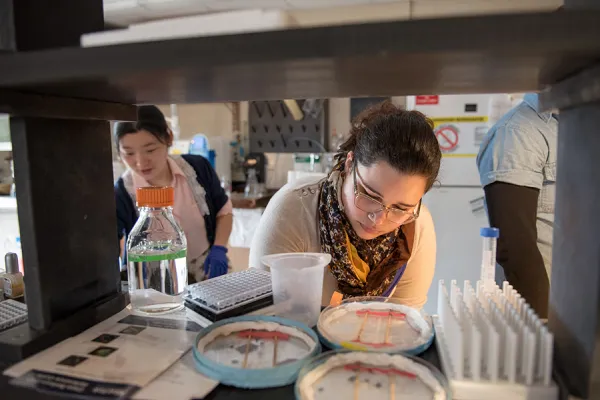Inclusive Excellence: Smith Shares Success in STEM Learning via New Website
Campus Life

Published July 18, 2016
In the nine years since Smith launched its Achieving Excellence in Mathematics, Engineering and Science (AEMES) program for underrepresented students in the sciences, the proportion of Smithies majoring in a STEM field has grown to more than 43 percent of the student body.
The success of the college’s AEMES program—which offers early research experiences, peer mentoring, research stipends and other supports—is highlighted on a new website created by colleges that have received funding from the Howard Hughes Medical Institute (HHMI).
Smith—which has been awarded $7 million in funding from HHMI over the past 25 years—is one of 11 liberal arts colleges and universities the institute has identified as models for improving science education. These HHMI “Capstone Institutions” were selected in recognition of their long history of HHMI funding and their success in achieving “inclusive excellence” in science education.
The new website, “Supporting STEM Success in a Liberal Arts Context,” features detailed information from each capstone school about programs and successful strategies in four major areas:
- Developing student inquiry skills through exposure to scientific problem-solving methods;
- Increasing persistence of all students in STEM fields;
- Fostering integrative and interdisciplinary learning; and
- Creating pathways to institutional change in support of outstanding science education.
Smith psychology professor Patricia DiBartolo, faculty director of the sciences, noted that AEMES is among the key strategies Smith has used to make progress in all four target areas. Others include the engineering design clinic, interdisciplinary majors and research centers, the Summer Research Fellowship Program and the Science Center Committee on Diversity.
“Smith is right at the cutting edge of notions about who can do research and who belongs in science,” DiBartolo said. “I am proud that we have been able to contribute so substantively to each of the themes on Smith’s profile page on the capstone website.”
Here’s what else DiBartolo had to say about science education at Smith:
What are some of Smith’s key strengths in teaching STEM?
Patricia DiBartolo: “A particular strength is persistence and building the pool of students drawn to STEM. Another source of pride here is the research opportunities available to students. It used to be that students would work towards an authentic research experience as a plum at the end of their undergraduate years. We have turned that paradigm on its head, realizing that if we want to draw people into STEM, we need to draw them into those experiences early.”
What impact has AEMES had on students at Smith?
DiBartolo: “Our AEMES scholars are now persisting in science at the highest rates in comparison to their peers. We’ve also seen an impact in grades earned in gateway science courses. One impetus for launching AEMES was the existence of grade gaps in those courses for students from groups historically underrepresented in STEM. Over time, we have closed that gap. Another really important piece is how our successes in AEMES have informed other ways of drawing women into science at Smith. What we’ve learned is that what helps students from underrepresented groups helps all students—practices such as broadening access to research and understanding what authentic scientific practice looks like. At Smith, AEMES is built on a successful peer mentoring program that benefits all students in the sciences.”
Another Smith strategy that seems important is the Science Center Committee on Diversity.
DiBartolo: “That’s one that really intrigued the other capstone institutions. For me, the most compelling part of the committee’s work has been the broad conversation it has sparked about how to pursue inclusive excellence through academic practice and structures. Because of the committee’s work, every department and program at Smith is required to analyze and address how they respond to diversity.”
What role has HHMI funding played in Smith’s successes in STEM?
DiBartolo: “HHMI has been a pivotal partner with us over the last 25 years. They’ve helped to seed all of our most successful ventures—from the very first tenure-track position in neuroscience (which is now a major), to AEMES, to our course-based research opportunities. Our partnership with HHMI has made possible the trying out of new ideas and the launching of ways to continue those programs beyond the life of the grants. Our Summer Science and Engineering Program for example, is now a self-sustaining program. And AEMES has been able to attract support from generous donors and is now part of the college’s ongoing operating budget.”
What are the next steps for boosting STEM learning at Smith?
DiBartolo: “One area we are paying more attention to is a focus on quantitative skills for students who enter college from underresourced high schools. That’s an issue across higher education, and we want to take a look at what we’re doing at Smith. We also want to build on our success in course-based research. In the three years I’ve been faculty director of the sciences, that conversation has really shifted. At first, people were skeptical of whether you could engage first-year students in meaningful research. But we’ve had students who have presented at national conferences at the end of their first year. We’re now exploring how we can have students doing course-based research in a more sustained way across our curriculum and across departments.”
Smith students doing research in Prof. Michael Barresi's zebrafish lab.